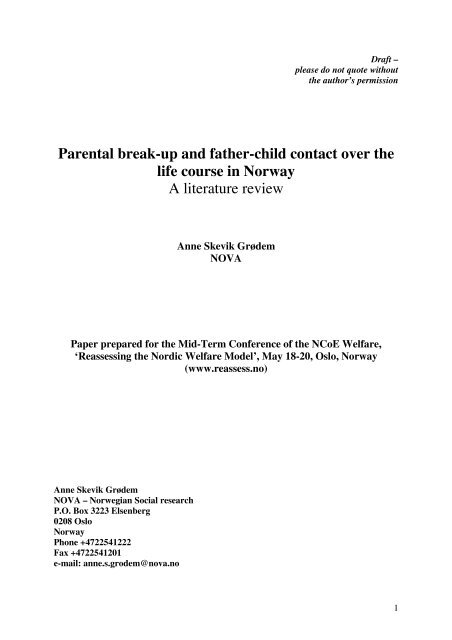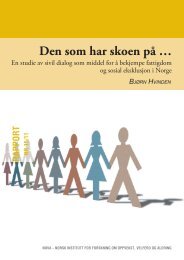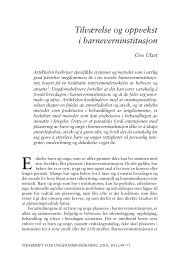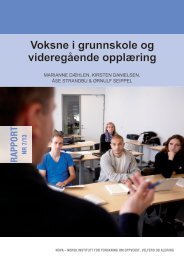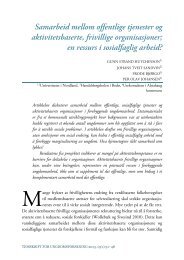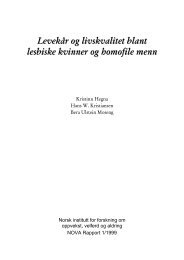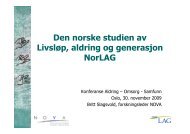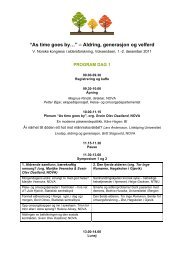Parental break-up and father-child contact over the life ... - Nova
Parental break-up and father-child contact over the life ... - Nova
Parental break-up and father-child contact over the life ... - Nova
Create successful ePaper yourself
Turn your PDF publications into a flip-book with our unique Google optimized e-Paper software.
Draft –<br />
please do not quote without<br />
<strong>the</strong> author’s permission<br />
<strong>Parental</strong> <strong>break</strong>-<strong>up</strong> <strong>and</strong> <strong>fa<strong>the</strong>r</strong>-<strong>child</strong> <strong>contact</strong> <strong>over</strong> <strong>the</strong><br />
<strong>life</strong> course in Norway<br />
A literature review<br />
Anne Skevik Grødem<br />
NOVA<br />
Paper prepared for <strong>the</strong> Mid-Term Conference of <strong>the</strong> NCoE Welfare,<br />
‘Reassessing <strong>the</strong> Nordic Welfare Model’, May 18-20, Oslo, Norway<br />
(www.reassess.no)<br />
Anne Skevik Grødem<br />
NOVA – Norwegian Social research<br />
P.O. Box 3223 Elsenberg<br />
0208 Oslo<br />
Norway<br />
Phone +4722541222<br />
Fax +4722541201<br />
e-mail: anne.s.grodem@nova.no<br />
1
Today 80 per cent of <strong>child</strong>ren live with <strong>the</strong>ir mo<strong>the</strong>rs after <strong>the</strong> <strong>break</strong>-<strong>up</strong> between <strong>the</strong> parents…<br />
Many <strong>fa<strong>the</strong>r</strong>s are frustrated with this unequal division <strong>and</strong> feel significantly weakened in <strong>the</strong>ir<br />
role as a parent as a consequence of having far less <strong>contact</strong> with, <strong>and</strong> responsibility for, <strong>the</strong><br />
<strong>child</strong>ren. (St.meld. nr. 8 (2008-2009):80)<br />
That many <strong>fa<strong>the</strong>r</strong>s have strongly reduced <strong>contact</strong> with <strong>the</strong>ir <strong>child</strong>ren after a <strong>break</strong>-<strong>up</strong>, can<br />
have consequences also in <strong>the</strong> longer run. The reduced <strong>contact</strong> appears to last, so that men<br />
will not receive <strong>the</strong> same care <strong>and</strong> concern from <strong>child</strong>ren as women do when <strong>the</strong>y grow older.<br />
This is a social consequence of gender inequality in earlier phases of <strong>life</strong> that is little<br />
discussed (op.cit. :82)<br />
The two quotes above come from <strong>the</strong> Norwegian g<strong>over</strong>nment’s report to <strong>the</strong> Parliament on<br />
men, masculinities <strong>and</strong> gender equality (St. meld. nr. 8 (2008-2009)). The report was<br />
launched in December 2008, <strong>and</strong> is <strong>the</strong> first-ever parliamentary report in Norwegian history to<br />
focus on gender equality from men’s perspective. As <strong>the</strong> quotes indicate, <strong>the</strong> g<strong>over</strong>nment is<br />
concerned about <strong>the</strong> marginalisation of men in relation to <strong>the</strong>ir <strong>child</strong>ren, <strong>and</strong> <strong>the</strong> consequences<br />
this marginalisation has in <strong>the</strong> short <strong>and</strong> long run.<br />
Rates of parental <strong>break</strong>-<strong>up</strong> – both as divorce <strong>and</strong> as <strong>break</strong>-<strong>up</strong> of cohabiting relationships – are<br />
high in Norway. While we have relatively good data on <strong>contact</strong> between non-resident parents<br />
<strong>and</strong> dependent <strong>child</strong>ren, information is scarce when it comes to <strong>contact</strong> between adult <strong>child</strong>ren<br />
<strong>and</strong> ageing parents. The purpose of this paper is to present an <strong>over</strong>view of what we know<br />
about <strong>fa<strong>the</strong>r</strong>-<strong>child</strong> <strong>contact</strong> after <strong>the</strong> <strong>break</strong>-<strong>up</strong> in various stages of <strong>life</strong>. The paper is a literature<br />
review, aimed at summing <strong>up</strong> what we know <strong>and</strong> identifying challenges for future research. I<br />
shall focus on Norway, <strong>and</strong> bring in evidence from o<strong>the</strong>r countries where this is necessary to<br />
compliment (<strong>the</strong> limited) Norwegian data.<br />
The paper proceeds as follows: first, I discuss <strong>the</strong> situation in Norway relative to that in o<strong>the</strong>r<br />
countries, with an emphasis on parental <strong>break</strong>-<strong>up</strong>, <strong>fa<strong>the</strong>r</strong>hood policies <strong>and</strong> practices, <strong>and</strong> <strong>the</strong><br />
exchange of help between adult <strong>child</strong>ren <strong>and</strong> <strong>the</strong>ir parents. Second, I consider <strong>the</strong><br />
complexities inherent in measuring <strong>and</strong> evaluating <strong>contact</strong>, before moving on to presenting<br />
Norwegian data about post-<strong>break</strong><strong>up</strong> <strong>contact</strong> between dependent <strong>child</strong>ren <strong>and</strong> <strong>the</strong>ir nonresident<br />
<strong>fa<strong>the</strong>r</strong>s. The final sections of <strong>the</strong> paper discusses patterns of <strong>contact</strong> between divorced<br />
<strong>fa<strong>the</strong>r</strong>s <strong>and</strong> <strong>the</strong>ir adult <strong>child</strong>ren: <strong>the</strong> level <strong>and</strong> determinants for such <strong>contact</strong>, evidence of crossnational<br />
variation, <strong>and</strong> possible explanations. The paper ends with a discussion of <strong>the</strong><br />
remaining gaps in research.<br />
2
Fa<strong>the</strong>rhood policies <strong>and</strong> practices in Norway<br />
Norway, like <strong>the</strong> o<strong>the</strong>r Nordic countries, has developed active policies to encourage men to be<br />
more involved in care work. The most important measure in <strong>the</strong>se policies is <strong>the</strong> “daddy<br />
quota” in parental leave, that is, sections of <strong>the</strong> parental leave period that must be taken by<br />
<strong>fa<strong>the</strong>r</strong>s or else are lost to <strong>the</strong> family (Br<strong>and</strong>th <strong>and</strong> Kv<strong>and</strong>e, 2003). There is some evidence to<br />
suggest that this policy does shape practices <strong>and</strong> attitudes, for instance, time-use studies show<br />
that <strong>fa<strong>the</strong>r</strong>s spent more time doing caring work in 2000 than <strong>the</strong>y did in 1970 (Kitterød, 2003).<br />
International comparisons of time-use also indicate that Nordic mo<strong>the</strong>rs <strong>and</strong> <strong>fa<strong>the</strong>r</strong>s have a<br />
slightly more gender-equal division of labour than parents in non-Nordic countries (Finch<br />
2006). Qualitative research indicates that <strong>fa<strong>the</strong>r</strong>s who take <strong>the</strong> opportunity to spend time alone<br />
with <strong>the</strong>ir infants during paternity leave seem to learn to interact with <strong>the</strong> <strong>child</strong> in a way that<br />
o<strong>the</strong>r <strong>fa<strong>the</strong>r</strong>s do not, <strong>and</strong> thus develop a more independent <strong>fa<strong>the</strong>r</strong>ing role (Br<strong>and</strong>th <strong>and</strong><br />
Kv<strong>and</strong>e, 2003:160ff).<br />
At <strong>the</strong> same time, <strong>the</strong> Nordic countries have higher divorce rates than most o<strong>the</strong>r European<br />
countries, <strong>and</strong> also very high rates of extra-marital births. Most of <strong>the</strong>se extra-marital births<br />
take place in cohabiting co<strong>up</strong>les, thus <strong>the</strong> <strong>fa<strong>the</strong>r</strong> is normally present in <strong>the</strong> household at <strong>the</strong><br />
time of birth. However, cohabiting co<strong>up</strong>les are even more unstable than marriages. This is<br />
also true for cohabitation with <strong>child</strong>ren (Liefbroer <strong>and</strong> Dourleijn, 2006; Texmon, 1999). For<br />
<strong>child</strong>ren born in <strong>the</strong> early 1990s, it has been estimated that 40 per cent will experience<br />
parental <strong>break</strong>-<strong>up</strong> before <strong>the</strong>ir 16 th birthday (Jensen <strong>and</strong> Clausen, 1997a). And in Norway, as<br />
in most o<strong>the</strong>r countries, <strong>child</strong>ren normally reside with <strong>the</strong>ir mo<strong>the</strong>r after a <strong>break</strong>-<strong>up</strong>. In a<br />
survey among parents living apart in 2004, 82 per cent said that <strong>the</strong> <strong>child</strong> lived with <strong>the</strong><br />
mo<strong>the</strong>r, 8 per cent that <strong>the</strong> <strong>child</strong> lived with <strong>the</strong> <strong>fa<strong>the</strong>r</strong>, <strong>and</strong> 10 per cent said that <strong>the</strong> <strong>child</strong> spent<br />
about <strong>the</strong> same amount of time in both households (Lyngstad <strong>and</strong> Kitterød, 2008:12).<br />
There have been several changes to <strong>the</strong> provisions for parents <strong>and</strong> <strong>child</strong>ren following a<br />
parental <strong>break</strong>-<strong>up</strong> in <strong>the</strong> last decade. The right of <strong>the</strong> <strong>child</strong> to be heard is streng<strong>the</strong>ned,<br />
following <strong>the</strong> incorporation of <strong>the</strong> UN Children’s Charter in Norwegian legislation in 2003<br />
(S<strong>and</strong>berg, 2004). The responsibility of <strong>the</strong> parents to determine <strong>child</strong> maintenance privately<br />
has been tightened <strong>up</strong>, so that <strong>the</strong>re is now a fee on public determination (Skevik, 2003).<br />
Proportional sharing of travelling costs in connection with <strong>contact</strong> between <strong>the</strong> non-resident<br />
parent <strong>and</strong> <strong>the</strong> <strong>child</strong> was introduced in 2002. The <strong>child</strong> maintenance system was revised in<br />
3
2003, with new guidelines that rewarded non-resident parents with extensive <strong>contact</strong> with<br />
<strong>the</strong>ir <strong>child</strong>ren ( (Skevik, 2003). In short, Norwegian policy makers have implemented a<br />
number of policies in order to encourage <strong>contact</strong> between <strong>fa<strong>the</strong>r</strong>s <strong>and</strong> <strong>child</strong>ren. Changes in<br />
practices are however slow, as discussed below.<br />
The family is an important provider of care for <strong>the</strong> elderly, as several studies have shown<br />
(e.g.Daatl<strong>and</strong> <strong>and</strong> Herlofson, 2004; Gautun, 2003, 2008). While <strong>the</strong>re are few comparative<br />
studies in this area, evidence available through <strong>the</strong> OASIS-study (Daatl<strong>and</strong> <strong>and</strong> Herlofson,<br />
2004) suggests that <strong>the</strong> amount of this help is no smaller in Norway than in o<strong>the</strong>r<br />
industrialised countries. Around 40 per cent of <strong>the</strong> frail elderly (75+) in Norway reported<br />
receiving some form of practical help from <strong>the</strong>ir family in this study, which is very similar to<br />
<strong>the</strong> UK, higher than in Germany <strong>and</strong> Israel, <strong>and</strong> slightly lower than in Spain (48 per cent). The<br />
findings from <strong>the</strong> study thus run contrary to any pessimistic accounts of welfare state efforts<br />
“crowding out” family solidarity, ra<strong>the</strong>r, <strong>the</strong> OASIS study suggests a division of work<br />
between families <strong>and</strong> welfare states (Daatl<strong>and</strong> <strong>and</strong> Herlofson, 2004).<br />
The OASIS study focused on <strong>the</strong> exchange of help. The introductory quote from <strong>the</strong><br />
g<strong>over</strong>nmental report on men <strong>and</strong> gender equality also emphasised that men might receive less<br />
care from <strong>the</strong>ir <strong>child</strong>ren than women do as <strong>the</strong>y grow older. This paper is less concerned with<br />
help, but ra<strong>the</strong>r brings <strong>the</strong> concern for <strong>contact</strong> from <strong>the</strong> “dependent <strong>child</strong>ren” stage into <strong>the</strong><br />
later stages in <strong>life</strong>. Contact is a necessary, but not sufficient, condition for exchange of help –<br />
in fact, <strong>the</strong> precise relationship between <strong>contact</strong> <strong>and</strong> help is an understudied topic in itself.<br />
However, research findings on how much <strong>contact</strong> parents <strong>and</strong> <strong>child</strong>ren have, how much help<br />
is exchanged <strong>and</strong> how good <strong>the</strong> relationship is, may very well depend on who we ask. That is<br />
<strong>the</strong> topic of <strong>the</strong> next section.<br />
Contact between parents <strong>and</strong> <strong>child</strong>ren: different perspectives<br />
When studying <strong>contact</strong> between parents <strong>and</strong> <strong>child</strong>ren, asking different people will elicit<br />
different responses <strong>and</strong> in turn give ra<strong>the</strong>r different impressions. This is well-known from <strong>the</strong><br />
study of <strong>contact</strong> between parents <strong>and</strong> young <strong>child</strong>ren after a parental <strong>break</strong>-<strong>up</strong>: custodial <strong>and</strong><br />
non-custodial parents will typically give different information about how much time <strong>the</strong> <strong>child</strong><br />
spends with <strong>the</strong> non-custodial parent. On <strong>the</strong> aggregated level, if we compare responses from<br />
4
separate samples of custodial <strong>and</strong> non-custodial parents, this patterns can at least partially be<br />
explained by patterns of non-response: it is likely that <strong>the</strong> most passive non-resident parents<br />
opt out of surveys of this sort, while <strong>the</strong> participation of custodial parents is unlikely to be<br />
strongly influenced by how much <strong>contact</strong> <strong>the</strong> <strong>child</strong> has. Samples will <strong>the</strong>refore contain<br />
“average” custodial parents <strong>and</strong> “active” non-custodial parents, which will lead to <strong>over</strong>all<br />
results where non-custodial parents as a gro<strong>up</strong> report higher levels of <strong>contact</strong> than custodial<br />
parents do (Jensen <strong>and</strong> Clausen, 1997b:23ff). However, even in studies that compare matched<br />
samples, that is, responses from custodial <strong>and</strong> non-custodial parents of <strong>the</strong> same <strong>child</strong>, this<br />
discrepancy between <strong>the</strong> reports of custodial <strong>and</strong> non-custodial parents is found (Braver et al.,<br />
1991; Kitterød, 2004b, 2004a). For instance, in <strong>the</strong> survey about <strong>contact</strong> <strong>and</strong> <strong>child</strong><br />
maintenance payments from Statistics Norway (see below), 83 per cent of non-resident <strong>fa<strong>the</strong>r</strong>s<br />
<strong>and</strong> 77 per cent of custodial mo<strong>the</strong>rs reported that <strong>the</strong> <strong>fa<strong>the</strong>r</strong> had spent time with <strong>the</strong> <strong>child</strong> in<br />
<strong>the</strong> last 30 days. 20 per cent of <strong>the</strong> <strong>fa<strong>the</strong>r</strong>s, <strong>and</strong> 31 per cent of <strong>the</strong> mo<strong>the</strong>rs, reported that <strong>the</strong><br />
<strong>child</strong> had not spent a single night with <strong>the</strong> <strong>fa<strong>the</strong>r</strong> in <strong>the</strong> last month. Discrepancies were even<br />
larger with regard to <strong>contact</strong> during <strong>the</strong> holidays: 42 percent of <strong>the</strong> <strong>fa<strong>the</strong>r</strong>s, <strong>and</strong> 24 per cent of<br />
<strong>the</strong> mo<strong>the</strong>rs, reported that <strong>the</strong> <strong>child</strong> had spent time with <strong>the</strong> <strong>fa<strong>the</strong>r</strong> during <strong>the</strong> most recent<br />
autumn <strong>break</strong>.<br />
Sample bias cannot explain <strong>the</strong>se discrepancies: <strong>the</strong>se analyses omitted all responses from<br />
participants who were not matched by <strong>the</strong> <strong>child</strong>’s o<strong>the</strong>r parent. How, <strong>the</strong>n, should we<br />
underst<strong>and</strong> <strong>the</strong> differences in mo<strong>the</strong>rs’ <strong>and</strong> <strong>fa<strong>the</strong>r</strong>s’ responses? One possible explanation is<br />
that mo<strong>the</strong>rs do not know how much time <strong>the</strong> <strong>child</strong> spends with his or her <strong>fa<strong>the</strong>r</strong>. As <strong>child</strong>ren<br />
grow older <strong>and</strong> more autonomous, <strong>the</strong>y may arrange to meet <strong>the</strong>ir <strong>fa<strong>the</strong>r</strong> without <strong>the</strong> mo<strong>the</strong>rs’<br />
knowledge. This is however unlikely to account for <strong>the</strong> discrepancy in <strong>the</strong> number of nights<br />
<strong>the</strong> <strong>child</strong> reportedly spends with his or her <strong>fa<strong>the</strong>r</strong> – it cannot be that common that <strong>child</strong>ren<br />
spend nights away from home without <strong>the</strong>ir parent knowing where <strong>the</strong>y are. We must<br />
<strong>the</strong>refore consider <strong>the</strong> explanation proposed by Bradshaw et al (1999:84), “…that lone<br />
mo<strong>the</strong>rs may not welcome, <strong>and</strong> be reluctant to acknowledge, <strong>the</strong> continuing involvement of a<br />
non-resident <strong>fa<strong>the</strong>r</strong>. Or <strong>the</strong>y may feel that <strong>the</strong> nature of that <strong>contact</strong> is to trivial to recognise.<br />
In contrast, <strong>the</strong> <strong>fa<strong>the</strong>r</strong>s may want to assert <strong>the</strong>ir parental role, <strong>and</strong> perhaps claim greater<br />
involvement than <strong>the</strong>y in reality have”. To <strong>the</strong> extent this explanation is valid, <strong>the</strong><br />
discrepancies observed are partly a result of continued conflict between <strong>the</strong> parents, <strong>and</strong> partly<br />
caused by <strong>the</strong> need for self-presentation that is observed in many surveys.<br />
5
Sample bias <strong>and</strong> self-presentation also present challenges in surveys looking into relationships<br />
between ageing parents <strong>and</strong> <strong>the</strong>ir adult <strong>child</strong>ren. For instance, a Norwegian study of exchange<br />
of practical help between parents <strong>and</strong> adult <strong>child</strong>ren showed that parents see <strong>the</strong>mselves as net<br />
providers of help until <strong>the</strong>ir mid-70s, while <strong>child</strong>ren see <strong>the</strong>mselves as net givers already in<br />
<strong>the</strong>ir early 40s, referring to parents who are about 70 <strong>and</strong> older (Daatl<strong>and</strong> <strong>and</strong> Herlofson,<br />
2006:153). In <strong>the</strong> OASIS study, outlined above, <strong>child</strong>ren on average reported giving a little<br />
more help than <strong>the</strong> parents reported receiving (Daatl<strong>and</strong> <strong>and</strong> Herlofson, 2004). The <strong>child</strong>ren<br />
wish to present <strong>the</strong>mselves as helpful, while <strong>the</strong> parents may wish to come across as selfsufficient.<br />
Different issues arise when studying <strong>the</strong> quality of relationships between adult <strong>child</strong>ren <strong>and</strong><br />
<strong>the</strong>ir parents. Here, a common finding is that parents describe relationships as closer <strong>and</strong> less<br />
conflicted than what <strong>child</strong>ren do (Rossi <strong>and</strong> Rossi, 1990; Herlofson <strong>and</strong> Hagestad, 2009). A<br />
common explanation for this is <strong>the</strong> “generational stake” <strong>the</strong>ory (Bengtson <strong>and</strong> Kuypers,<br />
1971), which emphasises <strong>the</strong> different psychological needs of <strong>the</strong> two generations at various<br />
stages of <strong>the</strong> <strong>life</strong> course. Young adults tend to emphasise conflict <strong>and</strong> difference in order to<br />
establish <strong>the</strong>ir independence <strong>and</strong> a separate sense of identity, while parents emphasise<br />
harmony <strong>and</strong> continuity. This pattern of positive parents <strong>and</strong> more negative <strong>child</strong>ren is<br />
however not uniform, as Aquilino (1999) has shown with US data. Analysing dyads of<br />
parents <strong>and</strong> <strong>child</strong>ren, he finds that parents <strong>and</strong> <strong>child</strong>ren agree on key characteristics of <strong>the</strong><br />
relationship in 54 per cent of <strong>the</strong> cases, parents are more positive than <strong>child</strong>ren in 25 per cent<br />
of <strong>the</strong> cases, while <strong>child</strong>ren are more positive than parents in 21 per cent of <strong>the</strong> cases. Patterns<br />
vary, among o<strong>the</strong>r things, with education levels in both generations. Aquilino (1999:869)<br />
argues that collection of equivalent data from both generations should be a st<strong>and</strong>ard procedure<br />
in designing research on parents <strong>and</strong> adult <strong>child</strong>ren, as <strong>the</strong> choice of informant has <strong>the</strong><br />
potential to severely alter <strong>the</strong> results. If this call is to be taken seriously, researchers should<br />
also aim at interviewing dyads of parents <strong>and</strong> <strong>child</strong>ren, to avoid <strong>the</strong> problems of self-selection<br />
<strong>and</strong> sample bias. While this form of research would be ideal, it is difficult to manage. Most of<br />
<strong>the</strong> studies quoted in this paper rely on information from only one perspective (parent or<br />
<strong>child</strong>), or on information from unmatched samples of parents <strong>and</strong> <strong>child</strong>ren.<br />
6
Contact between non-resident <strong>fa<strong>the</strong>r</strong>s <strong>and</strong> <strong>the</strong>ir young <strong>child</strong>ren<br />
Since <strong>the</strong> mid-1990s, <strong>the</strong>re have been four surveys in Norway on patterns of <strong>contact</strong> between<br />
non-resident parents <strong>and</strong> <strong>the</strong>ir <strong>child</strong>ren. The pioneering study was undertaken by Statistics<br />
Norway in 1996, <strong>and</strong> included (unmatched) custodial <strong>and</strong> non-resident parents identified<br />
through <strong>the</strong> population register (N=1256, response rates 71 among custodial parents <strong>and</strong> 57<br />
among non-resident parents) (Jensen <strong>and</strong> Clausen, 1997a). In 2001-2002, <strong>the</strong>re were three<br />
studies carried out almost simultaneously, though independently of each o<strong>the</strong>r. One was<br />
carried out at NOVA, <strong>and</strong> was a postal survey to non-resident <strong>fa<strong>the</strong>r</strong>s identified through <strong>the</strong><br />
National Insurance register of parents liable to pay <strong>child</strong> s<strong>up</strong>port (N= 584, response rate 54)<br />
(Skevik <strong>and</strong> Hyggen, 2002). The second was undertaken at <strong>the</strong> University of Bergen, as a<br />
postal survey to non-resident parents identified through <strong>the</strong> National Insurance register, <strong>and</strong><br />
through <strong>the</strong> membership records of <strong>the</strong> Norwegian Joint Custody association (N=1813,<br />
response rate 60) (Thuen, 2004). Unlike <strong>the</strong> NOVA survey, <strong>the</strong> Bergen sample included both<br />
mo<strong>the</strong>rs <strong>and</strong> <strong>fa<strong>the</strong>r</strong>s. By far <strong>the</strong> biggest study was however done by Statistics Norway, who<br />
interviewed both custodial <strong>and</strong> non-custodial parents of both sexes in 2002 <strong>and</strong> 2004. The<br />
sample in 2004 was drawn independently of <strong>the</strong> sample in 2002. The samples were matched,<br />
so that both parents in a parental co<strong>up</strong>le were interviewed (N2002=2306, response rate 59,<br />
N2004=2692, response rate 75). The 2002-round was postal survey with some follow-<strong>up</strong> by<br />
phone, <strong>the</strong> 2004-survey was a phone survey with some follow-<strong>up</strong> by post (Lyngstad <strong>and</strong><br />
Kitterød, 2008:6).<br />
All <strong>the</strong>se studies show that <strong>the</strong>re is extensive <strong>contact</strong> between non-resident parents – normally<br />
<strong>fa<strong>the</strong>r</strong>s – <strong>and</strong> <strong>the</strong>ir <strong>child</strong>ren in Norway. The proportion of non-resident parents who have<br />
never had <strong>contact</strong> with <strong>the</strong> <strong>child</strong> is between two <strong>and</strong> five per cent in all <strong>the</strong> studies, while <strong>the</strong><br />
proportion who have not had <strong>contact</strong> in <strong>the</strong> last year prior to <strong>the</strong> survey varied between eight<br />
<strong>and</strong> 11 per cent (Kitterød, 2004a; Kitterød <strong>and</strong> Lyngstad, 2006, 2007; Skevik, 2006; Skevik<br />
<strong>and</strong> Hyggen, 2002; Thuen, 2004). The proportion who report seeing <strong>the</strong>ir <strong>child</strong> at least once a<br />
month varies between about 80 (Kitterød, 2004a; Skevik <strong>and</strong> Hyggen, 2002) to 90 per cent<br />
(Thuen, 2004). Thuen (2004:47) found that a lack of routine monthly <strong>contact</strong> was often<br />
compensated by <strong>contact</strong> during holidays: <strong>the</strong> vast majority of parents who did not see <strong>the</strong>ir<br />
<strong>child</strong>ren regularly during <strong>the</strong> year, had <strong>contact</strong> with <strong>the</strong>m during <strong>the</strong> holidays. This was<br />
largely confirmed in similar analyses by Kitterød (Kitterød, 2004a:25, 2006).<br />
7
Comparing <strong>the</strong>se figures to similar findings from <strong>the</strong> survey in 1996 (Jensen <strong>and</strong> Clausen,<br />
1997a, 1997b) indicates that <strong>the</strong> proportions with regular <strong>contact</strong> increased somewhat during<br />
<strong>the</strong> second half of <strong>the</strong> 1990s. In <strong>the</strong> survey from 1996, six per cent of <strong>the</strong> <strong>fa<strong>the</strong>r</strong>s reported<br />
never having seen <strong>the</strong> <strong>child</strong>, while 12 per cent had not seen him or her during <strong>the</strong> last 12<br />
months. 77 per cent of <strong>the</strong> <strong>fa<strong>the</strong>r</strong>s had seen <strong>the</strong> <strong>child</strong> in <strong>the</strong> last month prior to <strong>the</strong> survey<br />
(Jensen <strong>and</strong> Clausen, 1997b:23ff). Lyngstad <strong>and</strong> Kitterød (2008:14) note a small increase in<br />
<strong>the</strong> average number of days non-resident parents had <strong>contact</strong> in <strong>the</strong> last month between 2002<br />
<strong>and</strong> 2004, <strong>and</strong> also a small – but not statistically significant – increase in <strong>the</strong> proportion who<br />
reported having shared physical custody. There is thus evidence that non-resident parents<br />
have gained somewhat in terms of <strong>contact</strong> in <strong>the</strong> last 10-15 years, but <strong>the</strong> changes are<br />
marginal.<br />
The figures also indicate that levels of <strong>contact</strong> in Norway are slightly higher than in many<br />
o<strong>the</strong>r countries in which this has been investigated. For instance, Bradshaw et al. (1999:91)<br />
found that 42 per cent of British <strong>fa<strong>the</strong>r</strong>s said <strong>the</strong>y had seen <strong>the</strong>ir <strong>child</strong> during <strong>the</strong> last week,<br />
while 28 per cent said it had been more than a week, but less than a month. This gives a total<br />
of 70 per cent who had seen <strong>the</strong>ir <strong>child</strong> in <strong>the</strong> last month. 17 per cent had not seen <strong>the</strong> <strong>child</strong> in<br />
a year or more, including those who had never seen <strong>the</strong> <strong>child</strong>. In Australia, only 51 per cent of<br />
custodial parents reported in 1997 that <strong>the</strong>ir <strong>child</strong> had regular <strong>contact</strong>, defined as meeting <strong>up</strong><br />
daily to once a month. 30 per cent reported that <strong>contact</strong> occurred less than once a year or<br />
never (Smyth <strong>and</strong> Wolcott, 2004). Since this information comes from custodial parents, who<br />
tend to report lower levels of <strong>contact</strong>, it cannot be compared directly to <strong>the</strong> Norwegian or<br />
British data. Still, <strong>the</strong> reported level of <strong>contact</strong> is so much lower, it is worth mentioning. This<br />
may indicate that <strong>the</strong> Norwegian policies to encourage <strong>fa<strong>the</strong>r</strong>-<strong>child</strong> <strong>contact</strong> has had a certain<br />
impact, although far more careful comparative research is needed before we can say anything<br />
definitive about this.<br />
What are <strong>the</strong> factors that influence <strong>the</strong> chances of non-resident parents <strong>and</strong> <strong>child</strong>ren having<br />
<strong>contact</strong>, <strong>and</strong> <strong>the</strong> extent of <strong>contact</strong> that <strong>the</strong>y have? Travelling distance is a key factor. This<br />
contributes significantly to <strong>the</strong> level of <strong>contact</strong> in all <strong>the</strong> relevant studies (Jensen <strong>and</strong> Clausen,<br />
1997b; Kitterød, 2004a, 2006; Skevik, 2006; Skevik <strong>and</strong> Hyggen, 2002; Thuen, 2004). Nonresident<br />
parents who live far from <strong>the</strong>ir <strong>child</strong>ren have less weekly/ monthly <strong>contact</strong>, but this is<br />
to some degree compensated through <strong>contact</strong> during <strong>the</strong> holidays. Many of <strong>the</strong>se parents<br />
actively maintain <strong>contact</strong> through phone calls, SMS <strong>and</strong> e-mailing (Skevik, 2006).<br />
8
Children’s age is also a key determinant for <strong>contact</strong>. Skevik <strong>and</strong> Hyggen (2002:62) <strong>and</strong><br />
Kitterød (2004b:41) both found that younger <strong>child</strong>ren have more <strong>contact</strong> than older <strong>child</strong>ren.<br />
In particular, <strong>child</strong>ren aged 15/ 16 <strong>and</strong> older st<strong>and</strong> out with lower levels of <strong>contact</strong>. Thuen<br />
(2004:54) modifies this slightly: he also finds that teenagers are less likely to spend weekends<br />
with <strong>the</strong>ir non-resident parents, but more likely to have <strong>contact</strong> during holidays. Kitterød<br />
(2006) finds that <strong>child</strong>ren aged 10-14 are far more likely than older <strong>child</strong>ren to spend holidays<br />
with non-resident <strong>fa<strong>the</strong>r</strong>s than <strong>child</strong>ren who are both younger <strong>and</strong> older. Age influences both<br />
<strong>the</strong> level <strong>and</strong> form of <strong>contact</strong>, although precisely how <strong>the</strong>se patterns look varies slightly<br />
between different surveys.<br />
The parent’s relationship history is ano<strong>the</strong>r important determinant for <strong>contact</strong>. A clear finding<br />
in all <strong>the</strong> studies quoted is that non-resident parents who have never lived with <strong>the</strong> custodial<br />
parent have much less <strong>contact</strong> than those who did live toge<strong>the</strong>r at <strong>the</strong> time of birth. But are<br />
<strong>the</strong>re differences between parents who have been married, <strong>and</strong> parents who cohabited without<br />
marriage? Findings in this respect are unclear. Jensen <strong>and</strong> Clausen (1999) analysed this very<br />
carefully, <strong>and</strong> found that while formerly married <strong>and</strong> cohabiting parents had <strong>the</strong> same average<br />
levels of <strong>contact</strong>, <strong>the</strong>re was far more variation among former cohabitees. In particular, <strong>the</strong><br />
levels of <strong>contact</strong> among formerly cohabiting parents depended on <strong>the</strong>ir education <strong>and</strong> income<br />
level: well-educated ex-cohabitees had more <strong>contact</strong> than similarly educated divorcees, while<br />
<strong>the</strong> low-educated had less (op.cit.: 301). Skevik <strong>and</strong> Hyggen (2002) <strong>and</strong> Kitterød (2004b) both<br />
found that formerly cohabiting parents had slightly lower levels of <strong>contact</strong> than <strong>the</strong> formerly<br />
married, but in both surveys <strong>the</strong> difference is very small <strong>and</strong> not significant. Thuen (2004)<br />
reports no differences at all. Skevik (2006) looked in particular at <strong>the</strong> extremes of <strong>the</strong><br />
distribution – parents with weekly <strong>contact</strong>, <strong>and</strong> parents who had not seen <strong>the</strong> <strong>child</strong> in more<br />
than 3 months – <strong>and</strong> found that while those who had never lived with <strong>the</strong> o<strong>the</strong>r parent were<br />
significantly less likely to be in <strong>the</strong> former gro<strong>up</strong>, <strong>and</strong> more likely to be in <strong>the</strong> latter,<br />
cohabitation had no effect on ei<strong>the</strong>r end of <strong>the</strong> distribution. It may be that cohabitation<br />
differed less from marriage in <strong>the</strong> early-mid-2000s than what was <strong>the</strong> case in 1996, <strong>the</strong>n<br />
again, none of <strong>the</strong> newer studies have aimed explicitly at <strong>up</strong>dating Jensen <strong>and</strong> Clausen’s<br />
(1999) finding. We can <strong>the</strong>refore not rule out that <strong>contact</strong> among former cohabitees varies<br />
more, <strong>and</strong> by different criteria, than what is <strong>the</strong> case for divorced parents.<br />
9
Findings are equally insecure when it comes to <strong>the</strong> impact of new partnerships among <strong>the</strong><br />
custodial <strong>and</strong>/ or non-custodial parents. In bivariate analyses, both Skevik <strong>and</strong> Hyggen (2002)<br />
<strong>and</strong> Kitterød (2004) find that non-resident parents who are single have more <strong>contact</strong> than<br />
those who have repartnered (by marriage or cohabitation). In multivariate analyses, this<br />
difference however disappears when controlled for factors such as <strong>the</strong> <strong>child</strong>’s age, time since<br />
<strong>the</strong> <strong>break</strong>-<strong>up</strong> <strong>and</strong> travelling distance. Kitterød (2004) finds no effect in multivariate analyses<br />
of custodial parents’ repartnering on how <strong>the</strong> custodial parent reports levels of <strong>contact</strong>. She<br />
has not looked at how <strong>the</strong> custodial parents’ repartnering might influence how non-resident<br />
parents report <strong>contact</strong>. This could be significant, given that Skevik <strong>and</strong> Hyggen (2002, app. A)<br />
<strong>and</strong> Skevik (2006) find relatively strong <strong>and</strong> negative effects of custodial mo<strong>the</strong>rs’<br />
repartnering on <strong>contact</strong> as reported by non-resident <strong>fa<strong>the</strong>r</strong>s (for a discussion, see Skevik<br />
2006:128).<br />
Jensen <strong>and</strong> Clausen (1997b) were particularly concerned with how social status, as measured<br />
by education, income <strong>and</strong> labour market participation, influence parent-<strong>child</strong> <strong>contact</strong>. Their<br />
findings indicate that resourceful parents (educated, high earnings, in employment) had more<br />
<strong>contact</strong> than less resourceful parents. A similar finding is reported by Thuen (2004). Skevik<br />
<strong>and</strong> Hyggen (2002) however found no significant effects of education <strong>and</strong> income, possibly<br />
due to limited variation on <strong>the</strong>se variables in this sample. In later analyses, Skevik (2004,<br />
2006) however found strong negative effects on levels of <strong>contact</strong> of <strong>the</strong> receipt of social<br />
assistance, which in turn is an indicator of p<strong>over</strong>ty <strong>and</strong> labour marked exclusion. This finding<br />
has been replicated in <strong>the</strong> larger-scale surveys by Statistics Norway (Kitterød <strong>and</strong> Lyngstad<br />
2006, 2007, Lyngstad <strong>and</strong> Kitterød 2008). Results from <strong>the</strong>se surveys also reveal clear<br />
associations between income, education <strong>and</strong> levels of <strong>contact</strong>, in line with <strong>the</strong> findings of<br />
Jensen <strong>and</strong> Clausen from 1996.<br />
With <strong>the</strong> three surveys from 2001-2002, <strong>and</strong> <strong>the</strong> 1996-survey before that, we have very good<br />
<strong>and</strong> reliable information about how much <strong>contact</strong> dependent <strong>child</strong>ren have with <strong>the</strong>ir nonresident<br />
parents, <strong>and</strong> <strong>the</strong> determinants for such <strong>contact</strong> in Norway. The situation with regard<br />
to continued <strong>contact</strong> after <strong>the</strong> <strong>child</strong>ren are grown is however not so well c<strong>over</strong>ed in research.<br />
The next section sums <strong>up</strong> what we know about <strong>the</strong> situation in Norway, s<strong>up</strong>plemented with<br />
evidence from o<strong>the</strong>r national contexts where relevant. The aim is <strong>the</strong> same as in this section –<br />
to review evidence regarding how much <strong>contact</strong> divorced <strong>fa<strong>the</strong>r</strong>s have with <strong>the</strong>ir <strong>child</strong>ren, <strong>and</strong><br />
10
<strong>the</strong> determinants for such <strong>contact</strong> – only now <strong>the</strong> emphasis is on adult <strong>child</strong>ren <strong>and</strong> ageing<br />
<strong>fa<strong>the</strong>r</strong>s.<br />
Contact between divorced <strong>fa<strong>the</strong>r</strong>s <strong>and</strong> <strong>the</strong>ir adult <strong>child</strong>ren<br />
American researchers have researched intergenerational relationships in families with<br />
divorced parents for two decades (e.g. Aquilino, 1994b, 1994a; Cooney <strong>and</strong> Uhlenberg, 1990;<br />
Lye et al., 1995; Shapiro, 2003). One of <strong>the</strong> most consistent findings from <strong>the</strong>se studies is that<br />
divorced <strong>fa<strong>the</strong>r</strong>s have less <strong>contact</strong> with <strong>the</strong>ir <strong>child</strong>ren than married <strong>fa<strong>the</strong>r</strong>s. Differences<br />
between divorced mo<strong>the</strong>rs <strong>and</strong> married mo<strong>the</strong>rs are typically smaller or not significant. Will<br />
we find <strong>the</strong> same in Norway?<br />
At <strong>the</strong> moment, <strong>the</strong> only larger-scale, representative survey that contains information about<br />
<strong>contact</strong> between adult <strong>child</strong>ren <strong>and</strong> <strong>the</strong>ir parents in Norway, is <strong>the</strong> NorLAG (The Norwegian<br />
Life-course, Ageing <strong>and</strong> Generation study). This is a panel study, where <strong>the</strong> first round of data<br />
collection was carried out in 2002-03 (N=5589, response rate 67%). NorLAG1 targeted<br />
persons who were 40 years or older. The second wave of NorLAG is part of LOGG (Life<br />
cOurse, Generations <strong>and</strong> Gender) which is a combination of NorLAG <strong>and</strong> <strong>the</strong> Norwegian<br />
version of <strong>the</strong> UN-anchored Generations <strong>and</strong> Gender Survey (GGS). Data collection took<br />
place in 2007-08 (total sample 15.156, response rate 60%). NorLAG2 comprises <strong>the</strong> original<br />
NorLAG sample, <strong>and</strong> an additional national representative sample of about 11.000 persons<br />
aged 18-79. Both data collections (NorLAG1 <strong>and</strong> NorLAG2/LOGG) combine telephone<br />
interviews, postal questionnaires <strong>and</strong> registry data (e.g. on household composition, family<br />
history, education, occ<strong>up</strong>ation, assets <strong>and</strong> debts, income <strong>and</strong> source of income). Compared to<br />
NorLAG1, NorLAG2/ LOGG is larger <strong>and</strong> includes a wider age range. As of yet, very little<br />
has been published from <strong>the</strong> NorLAG2/LOGG survey. The findings reviewed below are based<br />
on NorLAG1-data unless stated o<strong>the</strong>rwise. Since all respondents in NorLAG are aged 40 or<br />
older, it mainly conveys <strong>the</strong> opinions of parents with adult <strong>child</strong>ren. Respondents are however<br />
also asked about <strong>the</strong>ir relationship with <strong>the</strong>ir own parents, provided that <strong>the</strong>y have at least one<br />
living parent, thus relationships as seen by <strong>child</strong>ren aged 40 <strong>and</strong> <strong>over</strong> can also be explored<br />
(Daatl<strong>and</strong>, 2007).<br />
11
Among parents with adult <strong>child</strong>ren in <strong>the</strong> NorLAG survey, 24 per cent have experienced<br />
divorce (Daatl<strong>and</strong> <strong>and</strong> Herlofson, 2005:63). The proportion is higher among <strong>the</strong> younger<br />
respondents in <strong>the</strong> survey, which reflects that divorce has become increasingly common in<br />
recent years. Divorce rates were also higher among parents with higher education. About half<br />
of <strong>the</strong> male respondents who were divorced had repartnered, <strong>the</strong> same was true for one third<br />
of <strong>the</strong> divorced women (op.cit.:59).<br />
Five key indicators are used in NorLAG to measure intergenerational ties: (1) frequency of<br />
<strong>contact</strong>, (2) whe<strong>the</strong>r or not parents <strong>and</strong> <strong>child</strong>ren celebrate events (Christmas, birthdays,<br />
holidays) toge<strong>the</strong>r, (3) <strong>the</strong> parents’ subjective evaluation of <strong>the</strong> relationship to <strong>the</strong> (oldest)<br />
<strong>child</strong>, (4) receipt of help from <strong>the</strong>ir <strong>child</strong>ren, <strong>and</strong> (5) norms of filial responsibility. When<br />
looking at how divorce affects intergenerational relationships, this study finds negative effects<br />
of divorce on all indicators except normative solidarity (Daatl<strong>and</strong> <strong>and</strong> Herlofson, 2005). The<br />
effects are particularly strong for divorced men. As a gro<strong>up</strong>, divorced men <strong>and</strong> women have<br />
less <strong>contact</strong> with <strong>the</strong>ir <strong>child</strong>ren than married parents <strong>and</strong> widows/ widowers, <strong>the</strong>y more rarely<br />
celebrate events such as Christmas <strong>and</strong> birthdays, <strong>and</strong> <strong>the</strong>y have a slightly poorer relationships<br />
with <strong>the</strong> <strong>child</strong>ren. Divorced men also receive less help from <strong>the</strong>ir <strong>child</strong>ren, while no such<br />
effect is found for divorced women. All <strong>the</strong>se effects are net of effects of control variables<br />
which could influence <strong>the</strong> relationship between parental <strong>break</strong><strong>up</strong> <strong>and</strong> intergenerational<br />
relationships: age, education, health, <strong>and</strong> <strong>the</strong> number of <strong>child</strong>ren. A later analysis (Daatl<strong>and</strong><br />
<strong>and</strong> Herlofson, 2006:155) also controls for local environment (urban/ rural), <strong>and</strong> finds that <strong>the</strong><br />
negative effects of divorce are still visible when this is taken into account. The effects of<br />
divorce are stronger for men than for women, <strong>and</strong> appear to be stronger for <strong>contact</strong> than for<br />
<strong>the</strong> provision of help.<br />
Daatl<strong>and</strong> (2007) delves deeper into <strong>the</strong> effects of family change evidenced in <strong>the</strong> NorLAGmaterial,<br />
<strong>and</strong> asks how (1) divorce in <strong>the</strong> parent generation <strong>and</strong> (2) unmarried cohabitation in<br />
<strong>the</strong> <strong>child</strong>ren’s generation affects intergenerational solidarity. In line with <strong>the</strong> results outlined<br />
above, he finds clear effects of <strong>the</strong> parents’ divorce. No effects are however found for<br />
unmarried cohabitation (as compared to marriage) among <strong>child</strong>ren. Effects of divorce are<br />
stronger among <strong>fa<strong>the</strong>r</strong>s than among mo<strong>the</strong>rs, between two <strong>and</strong> three times stronger on five of<br />
<strong>the</strong> six indicators of solidarity. There is however also a negative effect for mo<strong>the</strong>rs, albeit not<br />
as strong. While this article discusses in-dept o<strong>the</strong>r demographic factors that influence<br />
<strong>contact</strong>, it does not discuss variation among <strong>the</strong> divorced mo<strong>the</strong>rs <strong>and</strong> <strong>fa<strong>the</strong>r</strong>s.<br />
12
Utilising data from NorLAG2/ LOGG, Herlofson <strong>and</strong> Hagestad (2009) have studied <strong>the</strong><br />
relationship between divorced parents <strong>and</strong> <strong>the</strong>ir adult <strong>child</strong>ren. The outcome variable <strong>the</strong>y<br />
focus on is relationship quality, as measured by responses to <strong>the</strong> question “how happy are you<br />
with your relationship to your mo<strong>the</strong>r/ <strong>fa<strong>the</strong>r</strong>/ oldest <strong>child</strong>?”. The main aim of this analysis is<br />
to illustrate <strong>the</strong> discrepancy between parents’ <strong>and</strong> <strong>child</strong>ren’s responses. Parents are generally<br />
very unlikely to describe <strong>the</strong> relationship to <strong>the</strong>ir <strong>child</strong> as poor, while <strong>child</strong>ren are far more<br />
likely to describe <strong>the</strong>ir relationship with <strong>the</strong>ir parents in this way. Never<strong>the</strong>less, whe<strong>the</strong>r one<br />
asks parents or <strong>child</strong>ren, relationships are poorer in families where <strong>the</strong> parents are divorced.<br />
Fa<strong>the</strong>r-daughter-relationships suffer particularly strongly: while fewer than one per cent of<br />
married <strong>fa<strong>the</strong>r</strong>s describe <strong>the</strong>ir relationship with <strong>the</strong>ir oldest daughter as poor, ten per cent of<br />
divorced <strong>fa<strong>the</strong>r</strong>s give this response. Correspondingly, six per cent of daughters whose parents<br />
are married describe <strong>the</strong>ir relationship with <strong>the</strong>ir <strong>fa<strong>the</strong>r</strong>s as poor, compared to more than 30<br />
per cent of daughters whose parents are divorced. Similar patterns, although far less strong,<br />
are found for relationships between mo<strong>the</strong>rs <strong>and</strong> daughters, sons <strong>and</strong> mo<strong>the</strong>rs, <strong>and</strong> sons <strong>and</strong><br />
<strong>fa<strong>the</strong>r</strong>s (Herlofson <strong>and</strong> Hagestad, 2009:26).<br />
Analyses based on NorLAG thus confirm <strong>the</strong> general finding from previous studies, mainly<br />
from <strong>the</strong> US: divorce has a negative effect on relationships between parents <strong>and</strong> <strong>child</strong>ren, <strong>and</strong><br />
<strong>fa<strong>the</strong>r</strong>s are more vulnerable in this respect than mo<strong>the</strong>rs. This is true for both <strong>contact</strong><br />
indicators (frequency of <strong>contact</strong>, joint celebration of events), for <strong>the</strong> subjective evaluation of<br />
relationship quality, <strong>and</strong> for receipt of help. So far, analyses of <strong>the</strong> NorLAG data have not<br />
discussed differences between gro<strong>up</strong>s of divorced mo<strong>the</strong>rs <strong>and</strong> <strong>fa<strong>the</strong>r</strong>s. Unlike what is <strong>the</strong><br />
case for studies of <strong>contact</strong> between dependent <strong>child</strong>ren <strong>and</strong> <strong>the</strong>ir parents, determinants for<br />
<strong>contact</strong> have not been a main topic in studies of adult <strong>child</strong>ren <strong>and</strong> <strong>the</strong>ir parents in Norway.<br />
Yet <strong>the</strong>re are a number of questions that could be raised, most obviously, how dependent is<br />
<strong>the</strong> relationship between adult <strong>child</strong>ren <strong>and</strong> <strong>the</strong>ir <strong>fa<strong>the</strong>r</strong>s on custody <strong>and</strong> <strong>contact</strong> arrangements<br />
when <strong>the</strong> <strong>child</strong>ren were young? In o<strong>the</strong>r words, do elderly <strong>fa<strong>the</strong>r</strong>s lose out because <strong>the</strong>y have<br />
not lived with <strong>the</strong>ir <strong>child</strong>ren, or are <strong>the</strong>re o<strong>the</strong>r reasons for this pattern? Ano<strong>the</strong>r crucial issue<br />
is repartnering: does repartnering in <strong>the</strong> parental generation increase or decrease <strong>contact</strong> with<br />
adult <strong>child</strong>ren? Does mo<strong>the</strong>rs’ reparterning have <strong>the</strong> same effect on <strong>contact</strong> as <strong>fa<strong>the</strong>r</strong>s’<br />
repartnering? What effects do characteristics of <strong>the</strong> <strong>child</strong>ren – <strong>the</strong>ir age, gender, marital <strong>and</strong><br />
parental status – have, <strong>and</strong> are <strong>the</strong>se effects similar for married <strong>and</strong> divorced mo<strong>the</strong>rs <strong>and</strong><br />
<strong>fa<strong>the</strong>r</strong>s? What happens when <strong>the</strong>re is divorce in both <strong>the</strong> parental <strong>and</strong> <strong>the</strong> <strong>child</strong> generation?<br />
13
Available analyses of Norwegian data cannot answer <strong>the</strong>se questions, we <strong>the</strong>refore turn to<br />
international literature in <strong>the</strong> next section.<br />
Why do <strong>contact</strong> decrease after divorce, <strong>and</strong> why are <strong>fa<strong>the</strong>r</strong>s more<br />
vulnerable?<br />
It is a relatively well-established finding in <strong>the</strong> international literature on intergenerational<br />
relationships <strong>over</strong> <strong>the</strong> <strong>life</strong> course that <strong>the</strong>re is a “divorce penalty” that particularly affects<br />
divorced men. Only recently have researchers been able to start <strong>the</strong> discussion of why this is<br />
so, that is, to examine differences between divorced men (<strong>and</strong> women) with different<br />
characteristics. There are three main hypo<strong>the</strong>ses in this respect: <strong>the</strong> “marital conflict”-<br />
hypo<strong>the</strong>sis, <strong>the</strong> “investment-hypo<strong>the</strong>sis” <strong>and</strong> <strong>the</strong> “marriage protection”-hypo<strong>the</strong>sis. The three<br />
are not mutually exclusive, but can very well operate in parallel.<br />
The marital conflict-hypo<strong>the</strong>sis is suggested by Svein Olav Daatl<strong>and</strong> (2007:823), who sees<br />
divorce as an indicator of parental conflict: “The negative association between parental<br />
divorce <strong>and</strong> <strong>the</strong> relationship to adult <strong>child</strong>ren can… be rephrased simply as a negative<br />
association between parental conflicts <strong>and</strong> <strong>the</strong> quality of <strong>the</strong> parent-<strong>child</strong> relationship”. This<br />
hypo<strong>the</strong>sis can explain why both parents experience a divorce penalty: long-term conflict in<br />
<strong>the</strong> family, <strong>and</strong> lack of success in dealing with such conflicts, tears away at parent-<strong>child</strong><br />
relationships. This would explain why <strong>child</strong>ren with divorced parents – <strong>and</strong>, presumably,<br />
<strong>child</strong>ren from high-conflict families where <strong>the</strong> parents have not divorced – maintain more<br />
distance to <strong>the</strong>ir parents than <strong>child</strong>ren whose parents are happily married. In order to test for<br />
this, we need to compare adult <strong>child</strong>ren with divorced parents, adult <strong>child</strong>ren with married<br />
high-conflict parents, <strong>and</strong> adult <strong>child</strong>ren from married low-conflict co<strong>up</strong>les.<br />
The investment-hypo<strong>the</strong>sis emphasises <strong>the</strong> investment parents have made in <strong>the</strong>ir <strong>child</strong>ren in<br />
<strong>the</strong>ir formative years: how much time <strong>the</strong>y have spent with <strong>the</strong>m, how involved <strong>the</strong>y have<br />
been in parenting (de Graaf <strong>and</strong> Fokkema, 2007; Kalmijn, 2007). The basic idea is that close<br />
parent-<strong>child</strong> relationships formed in <strong>the</strong> <strong>child</strong>’s early years will be maintained <strong>over</strong> <strong>the</strong> <strong>life</strong>course.<br />
Given <strong>the</strong> norm of reciprocity, parents who have been absent or distant through <strong>the</strong><br />
<strong>child</strong>’s formative years cannot expect to have frequent <strong>contact</strong> with <strong>the</strong>ir <strong>child</strong>ren once <strong>the</strong><br />
<strong>child</strong>ren are grown. To <strong>the</strong> extent this hypo<strong>the</strong>sis is true, custody ra<strong>the</strong>r than gender should<br />
14
determine post-divorce <strong>contact</strong>. The custodial parent is <strong>the</strong> parent who makes <strong>the</strong> (bigger)<br />
investment. Also, later divorces should matter less than early ones, widowhood should matter<br />
less than divorce, <strong>and</strong> parents who have been active <strong>and</strong> involved while married should<br />
experience a lower penalty than parents who were not.<br />
The investment hypo<strong>the</strong>sis is essentially backward-looking, emphasising <strong>the</strong> degree to which<br />
parents “invested” in <strong>the</strong>ir <strong>child</strong>ren during <strong>the</strong>ir formative years. The marital protection<br />
hypo<strong>the</strong>sis focuses on <strong>the</strong> here-<strong>and</strong>-now, <strong>and</strong> <strong>the</strong> propensity of ageing parents to actively<br />
maintain <strong>contact</strong> with <strong>the</strong>ir <strong>child</strong>ren. Women tend to take this role more actively than men do<br />
– women are <strong>the</strong> “kinkeepers” (Hagestad, 1986) in <strong>the</strong> family. It is generally mo<strong>the</strong>rs who<br />
arrange visits <strong>and</strong> does o<strong>the</strong>r work necessary to maintain <strong>contact</strong> between family members.<br />
Mo<strong>the</strong>rs may actively monitor <strong>the</strong> relationship between <strong>fa<strong>the</strong>r</strong>s <strong>and</strong> <strong>child</strong>ren, <strong>and</strong> try to<br />
improve <strong>the</strong> relationship in cases where it is poor. Married men benefit from this kinkeeping<br />
work in a way that divorced men <strong>and</strong> widowers do not, hence marriage has a protective<br />
function for men. According to this hypo<strong>the</strong>sis, men who live with a female partner should<br />
have more <strong>contact</strong> with <strong>the</strong>ir <strong>child</strong>ren than men who do not. It is worth noting that<br />
repartnering is expected to have opposite effects in <strong>the</strong> investment hypo<strong>the</strong>sis <strong>and</strong> <strong>the</strong><br />
marriage protection hypo<strong>the</strong>sis: repartnering can signal a move away from <strong>the</strong> original family<br />
(a “de-investment”) (de Graaf <strong>and</strong> Fokkema, 2007) <strong>and</strong> thus imply even less <strong>contact</strong> with<br />
<strong>child</strong>ren from <strong>the</strong> first marriage, on <strong>the</strong> o<strong>the</strong>r h<strong>and</strong>, it installs <strong>the</strong> man with a new potential<br />
kinkeeper <strong>and</strong> can thus imply more <strong>contact</strong> with <strong>child</strong>ren as well as o<strong>the</strong>r kin (Kalmijn 2007).<br />
Putting <strong>the</strong> marital conflict-hypo<strong>the</strong>sis to <strong>the</strong> test, American researchers Sobolewski <strong>and</strong><br />
Amato (2007) compares <strong>child</strong>ren from low-conflict marriages, <strong>child</strong>ren from high-conflict<br />
marriages <strong>and</strong> <strong>child</strong>ren of divorced parents in terms of <strong>the</strong>ir feelings of closeness to each of<br />
<strong>the</strong>ir parents. Their results indicate that <strong>child</strong>ren who grow <strong>up</strong> in low-conflict marriages<br />
typically feel close to both parents, more rarely close to only one parent, <strong>and</strong> are unlikely not<br />
to feel close to ei<strong>the</strong>r parent. Children who have grown <strong>up</strong> in high-conflict non-divorced<br />
families are as likely to feel alienated from both parents as <strong>the</strong>y are to feel close to both, <strong>and</strong><br />
rarely feel close to only one parent. Adult <strong>child</strong>ren with divorced parents very rarely feel close<br />
to both parents. They are as likely as <strong>child</strong>ren from high-conflict intact families to feel<br />
alienated from both parents, but <strong>the</strong> most common outcome is to feel close to only one parent.<br />
This s<strong>up</strong>ports Daatl<strong>and</strong>’s (2007) suggestion that marital conflict <strong>and</strong> divorce both tear away at<br />
<strong>child</strong>ren’s closeness to parents, but with an important qualification: Very simply put, <strong>child</strong>ren<br />
15
from high-conflict families typically ei<strong>the</strong>r develop close ties to both parents, or <strong>the</strong>y distance<br />
<strong>the</strong>mselves from both of <strong>the</strong>m. Children from divorced families ei<strong>the</strong>r distance <strong>the</strong>mselves<br />
from both parents, or <strong>the</strong>y develop close ties with one of <strong>the</strong>m – <strong>and</strong> this one is typically <strong>the</strong><br />
mo<strong>the</strong>r.<br />
Sobolewski <strong>and</strong> Amato (2007:1118) explain this latter finding – that <strong>child</strong>ren with divorced<br />
parents tend to feel close to only one parent – with patterns of residence after divorce.<br />
Children <strong>over</strong>whelmingly reside with <strong>the</strong>ir mo<strong>the</strong>rs after divorce, <strong>fa<strong>the</strong>r</strong>s <strong>and</strong> <strong>child</strong>ren have<br />
relationships “that are primarily recreational in nature…somewhat s<strong>up</strong>erficial… [making it]<br />
difficult for <strong>child</strong>ren <strong>and</strong> non-resident <strong>fa<strong>the</strong>r</strong>s to maintain deep <strong>and</strong> mutually-satisfying<br />
bonds”. They thus invoke a version of <strong>the</strong> investment-hypo<strong>the</strong>sis. This hypo<strong>the</strong>sis is put more<br />
carefully to <strong>the</strong> test in a Dutch study on parents’ degree of involvement in <strong>the</strong>ir young<br />
<strong>child</strong>ren, <strong>and</strong> <strong>contact</strong> between adult <strong>child</strong>ren <strong>and</strong> <strong>the</strong>ir parents (de Graaf <strong>and</strong> Fokkema 2007).<br />
This study indicates that <strong>the</strong> custody arrangement has a major effect on <strong>contact</strong> frequency.<br />
The big divide in this study is between parents who had custody <strong>and</strong> parents who did not. This<br />
factor alone explains about half of <strong>the</strong> difference between divorced <strong>and</strong> non-divorced parents.<br />
The study fur<strong>the</strong>r finds that remarriage has a negative effect on <strong>contact</strong> frequency, especially<br />
for mo<strong>the</strong>rs. Custodial arrangements <strong>and</strong> remarriage account for about 60 per cent of <strong>the</strong><br />
difference between divorced <strong>fa<strong>the</strong>r</strong>s <strong>and</strong> divorced mo<strong>the</strong>rs (de Graaf <strong>and</strong> Fokkema 2007:275).<br />
These findings are in line with <strong>the</strong> investment hypo<strong>the</strong>sis.<br />
De Graaf <strong>and</strong> Fokkema (2007:275) suggest that what is not explained by various aspects of<br />
investment perhaps can be explained by women’s role in <strong>the</strong> family: “men need <strong>the</strong>ir wives to<br />
maintain <strong>contact</strong> with adult <strong>child</strong>ren” (de Graaf <strong>and</strong> Fokkema 2007: 275). The baton is thus<br />
passed to <strong>the</strong> marital protection-hypo<strong>the</strong>sis. Kalmijn (2007) sets out to disentangle <strong>the</strong> effects<br />
of investment in <strong>child</strong>ren <strong>and</strong> marriage protection on patterns of post-divorce <strong>contact</strong> <strong>and</strong><br />
s<strong>up</strong>port between divorced parents <strong>and</strong> <strong>the</strong>ir <strong>child</strong>ren. Like de Graaf <strong>and</strong> Fokkema (2007), he<br />
uses data from <strong>the</strong> Ne<strong>the</strong>rl<strong>and</strong>s. He argues that in order to separate <strong>the</strong> effects of marital<br />
investment <strong>and</strong> marriage protection we need to differentiate four <strong>life</strong> course situations: (1) <strong>the</strong><br />
parents are married, (2) <strong>the</strong> parents divorced when <strong>the</strong> <strong>child</strong>ren were young, (3) <strong>the</strong> parents<br />
divorced when <strong>the</strong> <strong>child</strong>ren were older, <strong>and</strong> (4) one of <strong>the</strong> parents died. His results show that<br />
when married, mo<strong>the</strong>rs have more <strong>contact</strong> with <strong>the</strong>ir <strong>child</strong>ren than <strong>fa<strong>the</strong>r</strong>s. This gender gap<br />
tends to widen in circumstances of widowhood <strong>and</strong> divorce. Predictably, divorced parents<br />
have less <strong>contact</strong> with <strong>the</strong>ir <strong>child</strong>ren than married parents, <strong>and</strong> <strong>the</strong> effects are stronger for<br />
16
<strong>fa<strong>the</strong>r</strong>s than for mo<strong>the</strong>rs. Late divorces have less negative effects than early divorces.<br />
Widowed mo<strong>the</strong>rs have more <strong>contact</strong> with <strong>the</strong>ir <strong>child</strong>ren than married mo<strong>the</strong>rs, while<br />
divorced mo<strong>the</strong>rs have less. Widowed <strong>fa<strong>the</strong>r</strong>s, on <strong>the</strong> o<strong>the</strong>r h<strong>and</strong>, have less <strong>contact</strong> with<br />
<strong>child</strong>ren than married <strong>fa<strong>the</strong>r</strong>s. Both <strong>the</strong> investment hypo<strong>the</strong>sis <strong>and</strong> <strong>the</strong> marriage protection<br />
hypo<strong>the</strong>sis can contribute to explanations of <strong>the</strong>se findings: both a late divorce <strong>and</strong><br />
widowhood enlarge differences between men <strong>and</strong> women in <strong>the</strong>ir <strong>contact</strong> with <strong>child</strong>ren, which<br />
is consistent with <strong>the</strong> marriage protection hypo<strong>the</strong>sis. At <strong>the</strong> same time, effects are smaller for<br />
late than for early divorces, <strong>and</strong> smaller for widowhood than divorce, which is consistent with<br />
<strong>the</strong> hypo<strong>the</strong>sis that reduced investment in <strong>child</strong>ren when <strong>the</strong>y are young leads to less <strong>contact</strong><br />
later in <strong>life</strong>.<br />
Kalmijn (2007) brings <strong>up</strong> <strong>the</strong> issue of repartnering as a factor in parent-<strong>child</strong> <strong>contact</strong> beyond<br />
divorce. When <strong>fa<strong>the</strong>r</strong>s repartner, <strong>the</strong>y bring in a new potential female kinkeeper – will this<br />
bring relationships with <strong>child</strong>ren back to <strong>the</strong> post-divorce level? His analyses indicate that<br />
<strong>the</strong>y do not, in fact, <strong>the</strong>y do <strong>the</strong> opposite. There is a negative effect of remarriage, <strong>and</strong> this is<br />
stronger for <strong>fa<strong>the</strong>r</strong>s than for mo<strong>the</strong>rs. Dissolving <strong>the</strong> second union does not help in this respect<br />
ei<strong>the</strong>r. “The weakening of <strong>the</strong> relationship with <strong>child</strong>ren that occurs when a parent enters a<br />
new relationship is not reversed when that parent is alone again. The negative effect of<br />
remarriage appears irreversible” (Kalmijn 2007:1097). This is in line with de Graaf <strong>and</strong><br />
Fokkema’s (2007:273) findings, <strong>and</strong> can be interpreted as s<strong>up</strong>port for <strong>the</strong> investmenthypo<strong>the</strong>sis.<br />
All in all, however, Kalmijn (2007:1098) never<strong>the</strong>less highlights <strong>the</strong> explanatory<br />
power of <strong>the</strong> marriage protection hypo<strong>the</strong>sis.<br />
Taken toge<strong>the</strong>r, <strong>the</strong>se recent studies provide s<strong>up</strong>port for all <strong>the</strong> three main hypo<strong>the</strong>sis. High<br />
conflict in <strong>the</strong> family negatively affects intergenerational relationships <strong>over</strong> <strong>the</strong> <strong>life</strong> course,<br />
although apparently not in quite <strong>the</strong> same way as divorce (consistent with <strong>the</strong> marital conflicthypo<strong>the</strong>sis).<br />
Parents who have had custody have more frequent <strong>contact</strong> than parents who have<br />
not (consistent with <strong>the</strong> investment hypo<strong>the</strong>sis), <strong>and</strong> late divorces <strong>and</strong> widowhood also<br />
negatively affect <strong>fa<strong>the</strong>r</strong>s’ <strong>contact</strong> with <strong>child</strong>ren (consistent with <strong>the</strong> marriage protectionhypo<strong>the</strong>sis).<br />
It is still too early days to dismiss one hypo<strong>the</strong>sis in favour of ano<strong>the</strong>r, in any<br />
case, <strong>the</strong>re is no reason why not all three could be true at <strong>the</strong> same time.<br />
Studies that try to identify determinants for <strong>contact</strong> between adult <strong>child</strong>ren <strong>and</strong> <strong>the</strong>ir <strong>fa<strong>the</strong>r</strong>s<br />
are few <strong>and</strong> far between. Those reviewed here have relied on data from <strong>the</strong> US <strong>and</strong> <strong>the</strong><br />
17
Ne<strong>the</strong>rl<strong>and</strong>s. Can we assume that similar effects will be found in Norwegian data? In order to<br />
get some idea of similarities <strong>and</strong> differences between countries, I turn to comparative studies.<br />
Do comparisons of countries in Europe find <strong>the</strong> same patterns <strong>and</strong> mechanisms across all<br />
countries, or do <strong>the</strong>se things vary according to, for instance, national/ local culture <strong>and</strong><br />
welfare regime?<br />
Contact between adult <strong>child</strong>ren <strong>and</strong> divorced parents in Europe:<br />
comparative evidence<br />
Possibilities for comparing different countries in Europe have been vastly improved lately<br />
with <strong>the</strong> establishing of <strong>the</strong> SHARE project (Survey of Health, Ageing <strong>and</strong> Retirement in<br />
Europe). This is a large-scale survey with 27.500 respondents aged 50 years <strong>and</strong> older in 11<br />
European countries. The countries included are Sweden, Denmark, <strong>the</strong> Ne<strong>the</strong>rl<strong>and</strong>s, Belgium,<br />
Germany, France, Austria, Switzerl<strong>and</strong>, Italy, Spain <strong>and</strong> Greece. Interviewing took place in<br />
2004. The SHARE survey finds, like most similar surveys, that divorce leads to a weakening<br />
of parent-<strong>child</strong> bonds in many respects (Fokkema et al., 2008). Divorced parents live at a<br />
greater distance from <strong>the</strong>ir <strong>child</strong>ren, <strong>and</strong> <strong>the</strong>y have less frequent <strong>contact</strong> <strong>and</strong> weaker feelings<br />
of family care obligations than <strong>the</strong>ir continuously married counterparts. The <strong>over</strong>all results<br />
can be described as quite dramatic, particularly for <strong>fa<strong>the</strong>r</strong>s: as many as 12 per cent of <strong>the</strong><br />
divorced <strong>fa<strong>the</strong>r</strong>s in <strong>the</strong> survey had lost <strong>contact</strong> with <strong>the</strong>ir adult <strong>child</strong>ren all-toge<strong>the</strong>r. The same<br />
was true for two per cent of <strong>the</strong> divorced mo<strong>the</strong>rs, while practically no married mo<strong>the</strong>rs <strong>and</strong><br />
<strong>fa<strong>the</strong>r</strong>s had entirely lost <strong>contact</strong> with <strong>the</strong>ir <strong>child</strong>ren (Fokkema et al., 2008:31). At <strong>the</strong> o<strong>the</strong>r<br />
side of <strong>the</strong> distribution, more than 80 per cent of married mo<strong>the</strong>rs had <strong>contact</strong> with at least one<br />
of <strong>the</strong>ir <strong>child</strong>ren at least once a week, compared to 60 per cent of divorced mo<strong>the</strong>rs – <strong>and</strong> 46<br />
per cent of divorced <strong>fa<strong>the</strong>r</strong>s. Also, divorced parents have a weaker sense of family duty<br />
(op.cit.: 42).<br />
Kalmijn (2008) has used SHARE data in order to fur<strong>the</strong>r investigate <strong>the</strong> relationship between<br />
parental divorce, o<strong>the</strong>r background factors (including country of residence) <strong>and</strong> proximity <strong>and</strong><br />
<strong>contact</strong> between parents <strong>and</strong> <strong>child</strong>ren. Proximity is measured as physical distance to <strong>the</strong> <strong>child</strong>,<br />
while <strong>contact</strong> is measured by <strong>contact</strong> frequency. When comparing countries, Kalmijn (2008)<br />
identifies a negative relationship between traditionalism in gender roles <strong>and</strong> <strong>contact</strong> between<br />
divorced <strong>fa<strong>the</strong>r</strong>s <strong>and</strong> <strong>the</strong>ir adult <strong>child</strong>ren. That is, <strong>the</strong> more traditional gender roles in a<br />
18
society, <strong>the</strong> greater <strong>the</strong> reduction in <strong>fa<strong>the</strong>r</strong>-<strong>child</strong> <strong>contact</strong> after divorce. In practice, this means<br />
that effects of divorce on <strong>fa<strong>the</strong>r</strong>-adult <strong>child</strong> <strong>contact</strong> is stronger in countries like Italy <strong>and</strong> Spain<br />
than in countries like Sweden <strong>and</strong> <strong>the</strong> Ne<strong>the</strong>rl<strong>and</strong>s. The effects are however visible in all <strong>the</strong><br />
countries, including Sweden <strong>and</strong> Denmark.<br />
Tomassini et al (2004) also compared frequency of <strong>contact</strong> between parents <strong>and</strong> adult <strong>child</strong>ren<br />
in four European countries: Great Britain, Italy, <strong>the</strong> Ne<strong>the</strong>rl<strong>and</strong>s <strong>and</strong> Finl<strong>and</strong>. This article<br />
compares data from four (uncoordinated) national surveys, which limits <strong>the</strong> value of <strong>the</strong><br />
findings because of discrepancies both in <strong>the</strong> definitions of samples <strong>and</strong> in <strong>the</strong> definitions of<br />
key variables. Still, one finding from this article with regard to cross-national differences is<br />
especially worth noting: reduced <strong>contact</strong> between divorced mo<strong>the</strong>rs <strong>and</strong> <strong>the</strong>ir adult <strong>child</strong>ren is<br />
not found in any country but Finl<strong>and</strong>. In all <strong>the</strong> o<strong>the</strong>r countries in <strong>the</strong> study, only <strong>fa<strong>the</strong>r</strong>s are<br />
victims of <strong>the</strong> “divorce effect” on <strong>contact</strong> with adult <strong>child</strong>ren.<br />
Summing <strong>up</strong>: what we know, what we don’t<br />
About 40 per cent of <strong>child</strong>ren born in Norway since <strong>the</strong> 1990s are likely to experience<br />
parental <strong>break</strong>-<strong>up</strong> at some point during <strong>the</strong>ir <strong>child</strong>hood (Jensen <strong>and</strong> Clausen, 1997a). Thanks<br />
to a series of independent surveys on <strong>the</strong> topic, we know quite a lot about what happens to <strong>the</strong><br />
<strong>contact</strong> between parents <strong>and</strong> <strong>child</strong>ren in <strong>the</strong> years immediately following <strong>the</strong> <strong>break</strong>-<strong>up</strong>, while<br />
<strong>the</strong> <strong>child</strong>ren are young. We have far less information about what happens later in <strong>life</strong>, when<br />
<strong>the</strong> <strong>child</strong>ren grow <strong>up</strong> <strong>and</strong> <strong>the</strong> parents approach old age.<br />
Children <strong>over</strong>whelmingly reside with <strong>the</strong>ir mo<strong>the</strong>rs after a <strong>break</strong>-<strong>up</strong> in Norway, while<br />
maintaining regular <strong>contact</strong> with <strong>the</strong>ir <strong>fa<strong>the</strong>r</strong>s. 80-90 per cent of <strong>fa<strong>the</strong>r</strong>s in various surveys<br />
reported normally seeing <strong>the</strong>ir <strong>child</strong> at least monthly, <strong>and</strong> those who did not normally<br />
maintained <strong>contact</strong> through e-mail/ sms, phone-calls, <strong>and</strong> during <strong>the</strong> holidays. There is some<br />
evidence to suggest that levels of <strong>contact</strong> increased somewhat between <strong>the</strong> mid-1990s <strong>and</strong> <strong>the</strong><br />
mid-2000s. This would be in line with policy intentions; however, <strong>the</strong> changes are very small.<br />
Travelling distance between <strong>the</strong> parental homes, <strong>the</strong> <strong>child</strong>ren’s age, <strong>the</strong> parents’ previous<br />
relationship <strong>and</strong> ei<strong>the</strong>r parents’ repartnering all influence patterns <strong>and</strong> levels of <strong>contact</strong>, but<br />
<strong>the</strong> connections are not always simple <strong>and</strong> straight-forward. More<strong>over</strong>, weekend <strong>contact</strong> <strong>and</strong><br />
holiday <strong>contact</strong> appear to be two separate forms of <strong>contact</strong> with different variation patterns.<br />
19
The logic for studying <strong>contact</strong> between adult <strong>child</strong>ren <strong>and</strong> <strong>the</strong>ir parents is different than for<br />
studies of dependent <strong>child</strong>ren. Young <strong>child</strong>ren are dependent on <strong>the</strong>ir parents, adult <strong>child</strong>ren<br />
are not. Young <strong>child</strong>ren cannot cut ties with both parents simultaneously, thus is can be<br />
assumed that time not spent with <strong>the</strong> <strong>fa<strong>the</strong>r</strong> is spent with <strong>the</strong> mo<strong>the</strong>r. This is not <strong>the</strong> case with<br />
adult <strong>child</strong>ren – for <strong>the</strong>m, <strong>contact</strong> with both parents must be studied separately. Norwegian<br />
data clearly show that divorced <strong>fa<strong>the</strong>r</strong>s <strong>and</strong> mo<strong>the</strong>rs have less <strong>contact</strong> with <strong>the</strong>ir <strong>child</strong>ren than<br />
parents who have stayed married, <strong>and</strong> that this effect is stronger for <strong>fa<strong>the</strong>r</strong>s than for mo<strong>the</strong>rs.<br />
Recent evidence also suggest that <strong>the</strong> quality of relationships between divorced parents <strong>and</strong><br />
<strong>the</strong>ir <strong>child</strong>ren is lower than between married parents <strong>and</strong> <strong>the</strong>ir <strong>child</strong>ren, especially as<br />
described by <strong>the</strong> <strong>child</strong>ren. Relationships between daughters <strong>and</strong> <strong>the</strong>ir divorced <strong>fa<strong>the</strong>r</strong>s are<br />
particularly vulnerable.<br />
That divorced <strong>fa<strong>the</strong>r</strong>s have less <strong>contact</strong> with <strong>the</strong>ir <strong>child</strong>ren than married <strong>fa<strong>the</strong>r</strong>s, <strong>and</strong> also less<br />
than married mo<strong>the</strong>rs, is also found in several o<strong>the</strong>r European <strong>and</strong> American studies. There is<br />
some evidence to suggest, however, that <strong>the</strong> differences between divorced mo<strong>the</strong>rs <strong>and</strong> <strong>fa<strong>the</strong>r</strong>s<br />
is slightly smaller in <strong>the</strong> Sc<strong>and</strong>inavian countries than in Europe in general. Divorced mo<strong>the</strong>rs<br />
lose somewhat more in relation to married mo<strong>the</strong>rs regarding <strong>contact</strong> with <strong>the</strong>ir <strong>child</strong>ren,<br />
while divorced men lose a little less compared to married <strong>fa<strong>the</strong>r</strong>s. This is in line with<br />
Kalmijn’s (2008) suggestion, that <strong>the</strong> divorce penalty is harder for men in countries<br />
dominated by traditional gender roles than in countries with a more gender equal sharing of<br />
work. Evidence for such country differences is relatively weak, but all available evidence<br />
point in <strong>the</strong> same direction.<br />
These findings give reasons to be cautious about importing findings from one national context<br />
to ano<strong>the</strong>r. For instance, we have seen that evidence from <strong>the</strong> Ne<strong>the</strong>rl<strong>and</strong>s indicates that<br />
custody arrangement <strong>and</strong> repartnering are important determinants: <strong>fa<strong>the</strong>r</strong>s who have had<br />
custody have more <strong>contact</strong> than <strong>fa<strong>the</strong>r</strong>s who have not, <strong>and</strong> <strong>fa<strong>the</strong>r</strong>s who have not repartnered<br />
have more <strong>contact</strong> than <strong>fa<strong>the</strong>r</strong>s who have. There are many similarities between Norway <strong>and</strong><br />
<strong>the</strong> Ne<strong>the</strong>rl<strong>and</strong>s, but also important differences. One very obvious difference is population<br />
density: <strong>the</strong> Ne<strong>the</strong>rl<strong>and</strong>s is a small <strong>and</strong> very densely populated country, while <strong>the</strong> opposite is<br />
true in Norway (Tomassini et al 2004 makes this point with regard to Finl<strong>and</strong>). We have seen<br />
that distance between <strong>the</strong> parental homes is an important determinant for <strong>contact</strong> between<br />
young <strong>child</strong>ren <strong>and</strong> non-resident parents. Dutch parents are far less likely than Norwegian<br />
20
parents to live far away from each o<strong>the</strong>r, simply because <strong>the</strong>re is no “far away” as long as<br />
both remain within <strong>the</strong> boundaries of <strong>the</strong> Ne<strong>the</strong>rl<strong>and</strong>s. If <strong>child</strong>ren however grow <strong>up</strong> with <strong>the</strong>ir<br />
mo<strong>the</strong>rs in Tromsø <strong>and</strong> later set <strong>up</strong> <strong>the</strong>ir own homes in that city, <strong>the</strong>y are unlikely to have<br />
close ongoing <strong>contact</strong> with a <strong>fa<strong>the</strong>r</strong> who lives in Stavanger. This suggests that, if anything, <strong>the</strong><br />
impact of custodial arrangements should be stronger in Norway than what it is in <strong>the</strong><br />
Ne<strong>the</strong>rl<strong>and</strong>s, which would privilege custodial <strong>fa<strong>the</strong>r</strong>s in Norway even more than in <strong>the</strong><br />
Ne<strong>the</strong>rl<strong>and</strong>s.<br />
On <strong>the</strong> o<strong>the</strong>r h<strong>and</strong>, if levels of <strong>contact</strong> are high, “physical custody” becomes a legal term more<br />
than a lived reality. If <strong>the</strong> parents live in reasonable proximity to each o<strong>the</strong>r, <strong>and</strong> <strong>the</strong> <strong>child</strong><br />
divides her time between <strong>the</strong> parents 30-70 or 60-40, <strong>the</strong> <strong>child</strong> is likely to develop close ties<br />
with both parents regardless of formal custody arrangements. In Norway in 2002, 49 per cent<br />
of non-resident <strong>fa<strong>the</strong>r</strong>s reported that <strong>the</strong> <strong>child</strong> spent 8 or more days with <strong>the</strong>m per month<br />
(Kitterød 2004:39), while 17 per cent said <strong>the</strong> <strong>child</strong> was with <strong>the</strong>m for more than 13 days per<br />
month. Will <strong>fa<strong>the</strong>r</strong>s with such high levels of <strong>contact</strong> experience <strong>the</strong> same divorce penalty as<br />
o<strong>the</strong>r <strong>fa<strong>the</strong>r</strong>s? Is <strong>the</strong>re a threshold with respect to <strong>contact</strong> with dependent <strong>child</strong>ren for where<br />
<strong>the</strong> later-<strong>life</strong> penalty kicks in? In short, what is <strong>the</strong> relationship between levels of <strong>contact</strong> in<br />
<strong>the</strong> <strong>child</strong>’s early years, <strong>and</strong> levels of <strong>contact</strong> later in <strong>life</strong>? How crucial is <strong>the</strong> transition period<br />
made <strong>up</strong> by <strong>the</strong> <strong>child</strong>’s early adult years, say, 18-25? On <strong>the</strong>se issues, we have practically no<br />
information.<br />
Beside custody, <strong>the</strong> o<strong>the</strong>r factor that strongly influences Dutch <strong>contact</strong> patterns between adult<br />
<strong>child</strong>ren <strong>and</strong> divorced <strong>fa<strong>the</strong>r</strong>s is <strong>the</strong> <strong>fa<strong>the</strong>r</strong>s’ repartnering. Seen from <strong>the</strong> investment<br />
perspective, repartnering is an indication of withdrawn investment – <strong>the</strong> <strong>fa<strong>the</strong>r</strong> now invests in<br />
a new partner <strong>and</strong> possibly her <strong>child</strong>ren. From <strong>the</strong> marriage protection hypo<strong>the</strong>sis,<br />
repartnering might influence positively on <strong>contact</strong> levels if <strong>the</strong> new partner claims <strong>the</strong> role as<br />
kinkeeper in relation to <strong>the</strong> man’s <strong>child</strong>ren. The significance of repartnering can vary between<br />
contexts. For instance, in countries where divorce rates are high <strong>and</strong> have been so <strong>over</strong> time,<br />
“serial partnering” may be considered a fact of <strong>life</strong>. In such contexts, <strong>the</strong> repartnering of ei<strong>the</strong>r<br />
or both parents is more likely to be expected by <strong>child</strong>ren, <strong>and</strong> perhaps less seen as a betrayal<br />
to <strong>the</strong> original family – as a “withdrawal of investment”. More<strong>over</strong>, in such contexts people<br />
get used to separate between parenthood <strong>and</strong> partnership. Partners can come <strong>and</strong> go, while<br />
parenthood is for <strong>life</strong>. In recent years in Norway, <strong>the</strong>re has been a strong emphasis on <strong>the</strong><br />
biological principle, <strong>and</strong> a strong belief in <strong>the</strong> principle that nothing can alter <strong>the</strong> fundamental<br />
21
iological bond between parents <strong>and</strong> <strong>child</strong>ren. It is a basic principle in all debates on <strong>the</strong>se<br />
issues that parenthood continues beyond <strong>the</strong> partnership. On this background, adult <strong>child</strong>ren<br />
in Norway are less likely to be threatened by <strong>the</strong>ir <strong>fa<strong>the</strong>r</strong>s’ new partner than adult <strong>child</strong>ren in<br />
national cultures that lack this clear separation of parenthood <strong>and</strong> partnerships.<br />
The extent to which new partners take on kinkeeping responsibilities may also vary between<br />
contexts. Perhaps, in countries with traditional family norms, new partners have a distinct role<br />
in relation to <strong>child</strong>ren from previous relationships. In less traditional countries, scripts are less<br />
obvious <strong>and</strong> each person is left to figure out new roles for herself. This could imply more<br />
polarisation: new partners can decide she has a relationship with her new man only, <strong>and</strong> have<br />
no obligations in relation to his grown <strong>child</strong>ren. Alternatively, individualisation may open <strong>up</strong><br />
for unique individual relationships between new partners <strong>and</strong> adult <strong>child</strong>ren who are joined in<br />
<strong>the</strong>ir affection for <strong>the</strong> ageing <strong>fa<strong>the</strong>r</strong>.<br />
Demographic characteristics <strong>and</strong> family practices are two of <strong>the</strong> dimensions along which<br />
countries vary. Ano<strong>the</strong>r is welfare regime, including family policies. As mentioned,<br />
Norwegian family policies in recent years have aimed explicitly at increasing <strong>fa<strong>the</strong>r</strong>s’<br />
involvement in family <strong>life</strong>. How will this influence <strong>fa<strong>the</strong>r</strong>-<strong>child</strong> <strong>contact</strong> <strong>over</strong> time? Will<br />
<strong>fa<strong>the</strong>r</strong>s who have been more actively involved in <strong>the</strong>ir <strong>child</strong>ren’s <strong>up</strong>bringing suffer <strong>the</strong> divorce<br />
penalty? Will adult sons who are <strong>the</strong>mselves active <strong>fa<strong>the</strong>r</strong>s be more likely to maintain <strong>contact</strong><br />
with <strong>the</strong>ir own <strong>fa<strong>the</strong>r</strong>, <strong>and</strong> perhaps try to recruit him to active gr<strong>and</strong><strong>fa<strong>the</strong>r</strong>ing 1 ? Will daughters<br />
do <strong>the</strong> same for <strong>the</strong>ir <strong>fa<strong>the</strong>r</strong>s? On <strong>the</strong>se topics, it is particularly crucial to study developments<br />
<strong>over</strong> time.<br />
All <strong>the</strong> contributions reviewed in this paper have dealt with divorced <strong>fa<strong>the</strong>r</strong>s <strong>and</strong> <strong>the</strong>ir<br />
<strong>child</strong>ren. The analyses of <strong>contact</strong> between non-resident <strong>fa<strong>the</strong>r</strong>s <strong>and</strong> young <strong>child</strong>ren referred<br />
above however indicates that <strong>the</strong>re may be differences between <strong>fa<strong>the</strong>r</strong>s who have formally<br />
been married to <strong>the</strong> <strong>child</strong>’s mo<strong>the</strong>r, <strong>and</strong> those who have lived toge<strong>the</strong>r as cohabiting parents.<br />
Will we find differences along <strong>the</strong>se lines among adult <strong>child</strong>ren <strong>and</strong> <strong>the</strong>ir parents? Again, this<br />
is an area where we have no information.<br />
1 I am indebted to Gunhild Hagestad for this suggestion.<br />
22
Norway, like most o<strong>the</strong>r European countries, will experience population ageing in <strong>the</strong> coming<br />
decades. This greying of <strong>the</strong> population will take place against a backdrop of rapid family<br />
change. Patterns of intergenerational relationships will have a major impact on <strong>the</strong> quality of<br />
<strong>life</strong> for elderly Norwegians, <strong>and</strong> also – as pointed out in <strong>the</strong> g<strong>over</strong>nmental report on men <strong>and</strong><br />
gender equality – on <strong>the</strong> availability of family care <strong>and</strong> hence on <strong>the</strong> dem<strong>and</strong> for public<br />
welfare services. Yet Norwegian research on intergenerational relationships in modern<br />
families is still in its infancy. Indeed, in Europe in general, information is scarce about parent<strong>child</strong><br />
<strong>contact</strong> in later <strong>life</strong>. And even when <strong>the</strong> research situation improves in some countries, it<br />
is still not given that findings <strong>and</strong> conclusions can be imported from one context to ano<strong>the</strong>r –<br />
in fact this is ano<strong>the</strong>r empirical question. There are many reasons for family sociology <strong>and</strong><br />
family policy studies to move beyond <strong>the</strong>ir traditional myopic emphasis on families with<br />
dependent <strong>child</strong>ren, <strong>and</strong> recognise <strong>the</strong> importance of family relationships later in <strong>life</strong>.<br />
References<br />
Aquilino, W.S. (1994a), 'Later Life <strong>Parental</strong> Divorce <strong>and</strong> Widowhood - Impact on Young<br />
Adults Assessment of Parent-<strong>child</strong> Relations', Journal of Marriage <strong>and</strong> <strong>the</strong> Family,<br />
56: 4, 908-922.<br />
Aquilino, W.S. (1994b), 'Impact of Childhood Family Disr<strong>up</strong>tion on Young-Adults<br />
Relationships With Parents', Journal of Marriage <strong>and</strong> <strong>the</strong> Family, 56: 2, 295-313.<br />
Aquilino, W.S. (1999), 'Two views of one relationship: Comparing parents' <strong>and</strong> young adult<br />
<strong>child</strong>ren's reports of <strong>the</strong> quality of intergenerational relations', Journal of Marriage<br />
<strong>and</strong> <strong>the</strong> Family, 61: 4, 858-870.<br />
Bengtson, V.I. <strong>and</strong> Kuypers, J.A. (1971), 'Generational Difference <strong>and</strong> <strong>the</strong> Developmental<br />
Stake', Ageing <strong>and</strong> Human Development, 2: 4, 249-260.<br />
Bradshaw, J., Stimson, C., Skinner, C. <strong>and</strong> Williams, J. (1999), Absent Fa<strong>the</strong>rs?, London:<br />
Routledge.<br />
Br<strong>and</strong>th, B. <strong>and</strong> Kv<strong>and</strong>e, E. (2003), Fleksible fedre, Oslo: Oslo University Press.<br />
Braver, S.H., Wolchik, S.A., S<strong>and</strong>ler, I.N., Fogas, B.S. <strong>and</strong> Zvetina, D. (1991), 'Frequency of<br />
Visitation by Divorced Fa<strong>the</strong>rs - Differences in Reports by Fa<strong>the</strong>rs <strong>and</strong> Mo<strong>the</strong>rs',<br />
American Journal of Orthopsychiatry, 61: 3, 448-454.<br />
Cooney, T.M. <strong>and</strong> Uhlenberg, P. (1990), 'The Role of Divorce in Mens Relations with <strong>the</strong>ir<br />
Adult Children After Mid<strong>life</strong>', Journal of Marriage <strong>and</strong> <strong>the</strong> Family, 52: 3, 677-688.<br />
de Graaf, P.M. <strong>and</strong> Fokkema, T. (2007), 'Contacts between divorced <strong>and</strong> non-divorced parents<br />
<strong>and</strong> <strong>the</strong>ir adult <strong>child</strong>ren in <strong>the</strong> Ne<strong>the</strong>rl<strong>and</strong>s: An investment perspective', European<br />
Sociological Review, 23: 2, 263-277.<br />
Daatl<strong>and</strong>, S.O. <strong>and</strong> Herlofson, K. (2004), Familie, velferdsstat og aldring. Familiesolidaritet i<br />
et europeisk perspektiv., Oslo: NOVA.<br />
Daatl<strong>and</strong>, S.O. <strong>and</strong> Herlofson, K. (2005), 'Flere skilte: svekket familiesamhold?', in B.<br />
Slagsvold <strong>and</strong> P. E. Solem (eds.), Morgendagens eldre. En sammenligning av verdier,<br />
holdninger og atferd blant dagens middelaldrende og eldre, Oslo: NOVA.<br />
23
Daatl<strong>and</strong>, S.O. <strong>and</strong> Herlofson, K. (2006), 'Familien i <strong>and</strong>re halvdel av livet', in B. Slagsvold<br />
<strong>and</strong> S. O. Daatl<strong>and</strong> (eds.), Eldre år, lokale variasjoner. Resultater fra Den norske<br />
studien av livsløp, aldring og generasjon (NorLAG) - runde 1, Oslo: NOVA.<br />
Daatl<strong>and</strong>, S.O. (2007), 'Marital history <strong>and</strong> intergenerational solidarity: The impact of divorce<br />
<strong>and</strong> unmarried cohabitation', Journal of Social Issues, 63: 4, 809-825.<br />
Fokkema, T., ter Berke, S. <strong>and</strong> Dykstra, P.A. (2008), Solidarity between parents <strong>and</strong> <strong>the</strong>ir<br />
adult <strong>child</strong>ren in Europe, <strong>the</strong> Hague: NIDI.<br />
Gautun, H. (2003), Økt individualisering og omsorgsrelasjoner i familien. Omsorgsmønstre<br />
mellom middelaldrende kvinner og menn og deres gamle foreldre, Oslo: Fafo.<br />
Gautun, H. (2008), Arbeidstakere og omsorg for gamle foreldre - den nye tidsklemma., Oslo:<br />
Fafo.<br />
Hagestad, G.O. (1986), 'The Family: Women <strong>and</strong> r<strong>and</strong>parents as Kinkeepers', in A. Pifer <strong>and</strong><br />
L. Bronte (eds.), Our Ageing Society: Paradox <strong>and</strong> Promise.<br />
Herlofson, K. <strong>and</strong> Hagestad, G. (2009), 'God relasjon? Det spørs hvem som spørres.',<br />
Samfunnsspeilet: 1, 25-28.<br />
Jensen, A.-M. <strong>and</strong> Clausen, S.-E. (1997a), Barns familier. Samboerskap og foreldrebrudd<br />
etter 1970., Oslo: NIBR.<br />
Jensen, A.-M. <strong>and</strong> Clausen, S.-E. (1997b), Samvær og fravær. Foreldres kontakt med barn de<br />
ikke bor sammen med., Oslo: NIBR.<br />
Jensen, A.-M. <strong>and</strong> Clausen, S.-E. (1999), 'Samboerskap som foreldreskap, NOU 1999:25,<br />
Samboerne og samfunnet. Vedlegg 3. , Oslo: Statens forvaltningstjeneste.<br />
Kalmijn, M. (2007), 'Gender differences in <strong>the</strong> effects of divorce, widowhood <strong>and</strong> remarriage<br />
on intergenerational s<strong>up</strong>port: Does marriage protect <strong>fa<strong>the</strong>r</strong>s?', Social Forces, 85: 3,<br />
1079-1104.<br />
Kalmijn, M. (2008), 'The effects of separation <strong>and</strong> divorce on parent-<strong>child</strong> relationships in ten<br />
European countries', in C. Saraceno (ed.), Families, Ageing <strong>and</strong> Social Policy,<br />
Cheltenham: Edward Elgar.<br />
Kitterød, R.H. (2003), Tid til barna? Tidsbruk og samvær med barn blant mødre med barn i<br />
kontantstøttealder , Oslo: Statistics Norway.<br />
Kitterød, R.H. (2004a), 'Samvbær med barn etter samlivsbrudd: hva svarer far og hva svarer<br />
mor?', Samfunnsspeilet: 2.<br />
Kitterød, R.H. (2004b), Foreldreskap på tvers av hushold. Ansvar og omsorg for foreldre som<br />
ikke bor sammen. Resultater fra undersøkelsen om samvær og bidrag 2002 , Oslo:<br />
Statistics Norway.<br />
Kitterød, R.H. (2006), 'Stor avst<strong>and</strong> - lite samvær? Samværsfedres tid med barn per måned og<br />
i ferier', Tidsskrift for velferdsforskning, 9: 2, 100-115.<br />
Kitterød, R.H. <strong>and</strong> Lyngstad, J. (2006), Mest samvær blant ressurssterke fedre? Betydningen<br />
av inntekt og utdanning for samværsfedres kontakt med barna, Oslo: Statistics<br />
Norway.<br />
Kitterød, R.H. <strong>and</strong> Lyngstad, J. (2007), Samværsfedre - sammenheng mellom inntekt og<br />
kontakt med barna også etter bidragsreformen, Oslo: Statistics Norway.<br />
Liefbroer, A.C. <strong>and</strong> Dourleijn, E. (2006), Unmarried cohabitation <strong>and</strong> union stability: Testing<br />
<strong>the</strong> role of diffusion using data from 16 European Countries: Population Assn Amer.<br />
Lye, D.N., Klepinger, D.H., Hyle, P.D. <strong>and</strong> Nelson, A. (1995), 'Childhood Living<br />
Arrangements <strong>and</strong> Adult Childrens Relations With Their Parents', Demography, 32: 2,<br />
261-280.<br />
Lyngstad, J. <strong>and</strong> Kitterød, R.H. (2008), Samvær og bidrag 2002-2004. Sluttrapport., Oslo:<br />
Statistics Norway.<br />
Rossi, A.S. <strong>and</strong> Rossi, P.H. (1990), Of human bonding. Parent-<strong>child</strong> relations across <strong>the</strong> <strong>life</strong><br />
course, New York: Aldine de Gruyter.<br />
24
S<strong>and</strong>berg, K. (2004), 'Inkorporeringen av FNs barnekonvensjon i norsk rett', Kritisk Juss, 30:<br />
1, 316-329.<br />
Shapiro, A. (2003), 'Later-<strong>life</strong> divorce <strong>and</strong> parent-adult <strong>child</strong> <strong>contact</strong> <strong>and</strong> proximity - A<br />
longitudinal analysis', Journal of Family Issues, 24: 2, 264-285.<br />
Skevik, A. <strong>and</strong> Hyggen, C. (2002), Samværsfedrenes situasjon. Rapport fra en<br />
spørreundersøkelse, Oslo: NOVA.<br />
Skevik, A. (2003), 'The New Family's Vulnerable Vanguard: Child Maintenance Reform in<br />
Norway', Social Policy <strong>and</strong> Society, 3: 1, 11-19.<br />
Skevik, A. (2006), ''Absent <strong>fa<strong>the</strong>r</strong>s' or 'reorganized families'? Variations in <strong>fa<strong>the</strong>r</strong>-<strong>child</strong><br />
<strong>contact</strong> after parental <strong>break</strong>-<strong>up</strong> in Norway', Sociological Review, 54: 1, 114-132.<br />
Smyth, B. <strong>and</strong> Wolcott, I. (2004), 'Why study parent-<strong>child</strong> <strong>contact</strong>?', in B. Smyth (ed.),<br />
Parent-Child Contact <strong>and</strong> Post-Separation Parenting Arrangements, Melbourne:<br />
Australian Institute of Family Studies.<br />
Sobolewski, J.M. <strong>and</strong> Amato, P.R. (2007), 'Parents' discord <strong>and</strong> divorce, parent-<strong>child</strong><br />
relationships <strong>and</strong> subjective well-being in early adulthood: Is feeling close to two<br />
parents always better than feeling close to one?', Social Forces, 85: 3, 1105-1124.<br />
St.meld. nr. 8 (2008-2009), Om menn, mannsroller og likestilling. Oslo: Barne-og<br />
likestillingsdepartementet<br />
Texmon, I. (1999), 'Samliv i Norge mot slutten av 1990-tallet., NOU 1999:25, Samboerne og<br />
samfunnet. Vedlegg 3. , Oslo: Statens forvaltningstjeneste.<br />
Thuen, F. (2004), Livet som deltidsforeldre, Bergen: Fagbokforlaget.<br />
Tomassini, C., Kalogirou, S., Grundy, E., Fokkema, T., Martikainen, P., van Groenou, M.B.<br />
<strong>and</strong> Karisto, A. (2004), 'Contacts between elderly parents <strong>and</strong> <strong>the</strong>ir <strong>child</strong>ren in four<br />
European countries: current patterns <strong>and</strong> future prospects', European Journal of<br />
Ageing, 1: 1, 54-63.<br />
25


